ELCAN scope mounted on a Diemaco SFW (Special Forces Weapon). Notice the back-up sight mounted in front of the ELCAN scope.
By Christopher R. Bartocci
With the increase use of tactical carbines by law enforcement, a whole new breed of sights have been developed and employed for law enforcement applications. Many of the currently available sights began life as military sights and carried over to law enforcement.
In the U.S. Armed Forces, optics have only been used for special applications such as for snipers or sharpshooters. The standard combat rifle remains to have the mainstay with conventional iron sights. Combat rifles are subjected to the harshest environments including mud, dirt, snow and rain; all of which can render an optic useless. Without immediate accessibility to a backup iron sight the weapon will be ineffectual and may cost the soldier his life. Not to mention the issues of batteries dieing at the wrong time or the tritium lamp dieing at an inopportune moment.
However, for Special Operations use on the most advanced level, operators may be trained to deal with these downfalls and, once they have this new breed of tactical sight, they bring incredible advantages: in particular to the close quarter battle or CQB arena. This is also the arena that law enforcement most often encounters.
There are many sight options out in the market today and here we will look at a few of the most popular. All are excellent sight systems and have their own individual advantages and disadvantages. To begin with, the most popular sight used in Close Quarter Battle situations, both military and law enforcement, is the reflex sight.
Reflex sights differ from standard scopes in the fact they do not magnify in the normal way. They provide a large dot or sight inside a screen. The dot or hologram is adjusted just like a scope but designed for quick site acquisition when the operator has little time to react. Due to no magnification, the shooter will be able to fire with both eyes open increasing peripheral vision and speed. Among the most popular reflex sights in the marketplace are the Aimpoint M68 Comp 2, Trijicon ACOG and the EOTech Holographic sight.
The Aimpoint M68 CompM2
This is the most mass produced reflex sight made; adopted by U.S. Forces in 1997 as the M68 Reflex sight as well as SOPMOD Block 2. This uses 3-volt Lithium battery type 2L76 or DL1/3N batteries which may be its only negative aspect due to cold weather use. The sight has a red dot sight and is adjustable for brightness by a dial on the sight. This sight has become issue and may be seen on numerous M4 and M16A4 rifles in Afghanistan and Iraq.
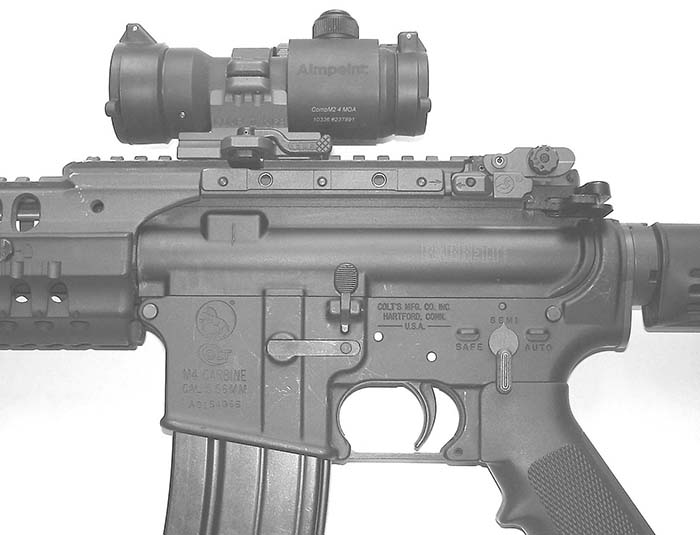
The sight can be mounted many different ways with different mounts. One of the most popular is the ARMS/Swan throw lever mounts (#17). ARMS offers a spacer to raise the sight up about 1 inch. When the sight is mounted on the receiver with an ARMS #40L back up rear sight, it allows co-witness in case the battery was to die. By flipping up the back up sight, the shooter will be able to see both iron sights and engage the target. The other benefit to using the throw lever mounts is that if the optic was to become damaged, unusable or the batteries die out, under stress, the sight can be removed in seconds rather than having to unscrew one or two nuts.
No deficiencies were found during testing other than the use of a battery. If it should go out at an inopportune moment and the shooter does not have back-up sights it could be a problem. However, keeping fresh batteries on hand and replacing them before any mission, this is an excellent sight. Being able to adjust the brightness, the accuracy is increased. With use in short range the brighter the better but when engaging 100 yards and beyond it is more advisable for a dimmer setting causing the dot to become smaller and more defined.
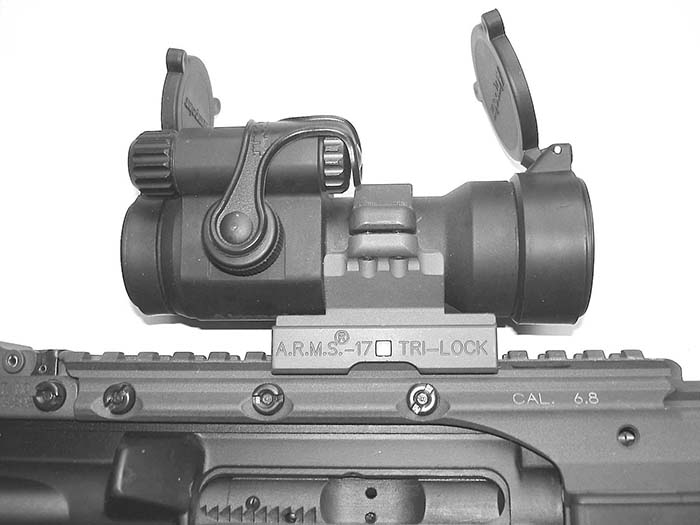
Trijicon ACOG Reflex Sight
This sight has seen extensive use by USSOCOM (United States Special Operations Command) as part of their SOPMOD enhancement program. This is by far the most durable of all of the sights due to its 7075T6 aluminum body: the same as the M16-series/M4 receivers. Unlike the M68, the ACOG (Advanced Combat Optical Gunsight) uses a tritium lamp instead of batteries. That lamp has a 10-year life giving it an incredible boost in reliability and Tritium is not affected by any weather conditions. Additionally, the dot is amber in color instead of red as it is claimed by Trijicon that amber is more visible to the eye than red. Provided with the sight is a polarizing filter. There are several good mounts for this sight but the ARMS, Inc #15 throw lever mount is the most versatile of the lot.
Adjustments are made in point of impact with a screwdriver or the base of a 5.56x45mm cartridge. A collimator in the front of the sight adjusts the intensity of the dot by the amount of light outside the optic.
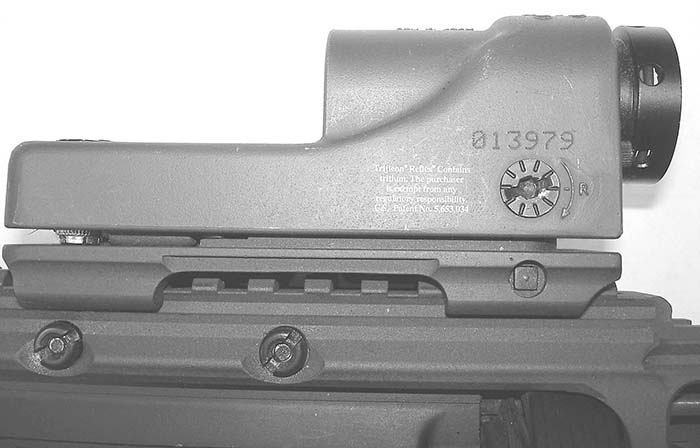
While it is comforting to know that no batteries are used, the sightscreen is dark and small compared to the M68 which gives a clearer sightscreen than the AGOG. In bright conditions the darker screen can be advantageous. Groups remained less than 3 inches at 100 yards with a Colt M4 carbine with Black Hills MK262 MOD 1 ammunition.
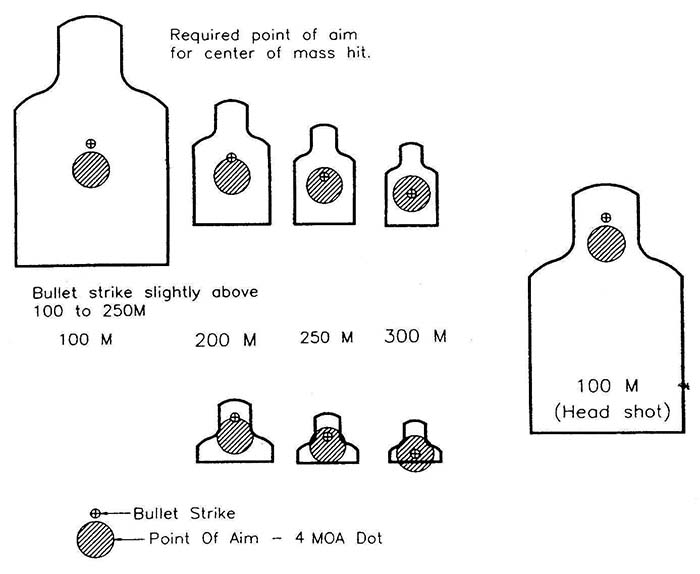
The Elcan Optical Sight
Perhaps the most manufactured combat sight of all time is the Elcan optical sight by Armament Technologies up in the Great White North in Canada. It was adopted for general use by the Canadian military and many of their foreign military customers. The U.S. military has adopted a customized Elcan scope for use on the M249 SAW (Squad Automatic Weapon).
While not necessarily a reflex sight, it is worth mentioning due to the way the sight can be utilized. There is a triangular shaped aperture in a spear form. The tip of the sight glows with Tritium so no batteries are required. The scope has a 4/20 magnification, which is optimal for a combat scope keeping extremely quick sight acquisition.
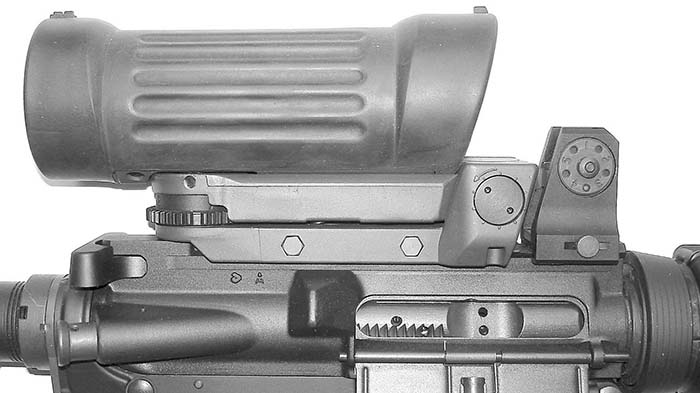
Due to the low power and the tritium lamp in the reticle, this sight may also be used as a close quarter battle reflex sight. Up close the picture will not be as clear, but clear enough to accomplish the job, with the additional advantage of engaging targets beyond 400 meters.
Shooting with this sight is very effective. The ability to engage accurately at longer ranges versus an iron sight is an incredible advantage. The glowing aiming point is truly there for close-up work due to the fact you will not see a target 400 meters away in the dark. Using the ELCAN in CQB conditions has proved to be effective and is an excellent choice for a combat scope with magnification. The durability and quality are second to none. This sight has an incredible service record being the most mass-produced combat scope in the world.
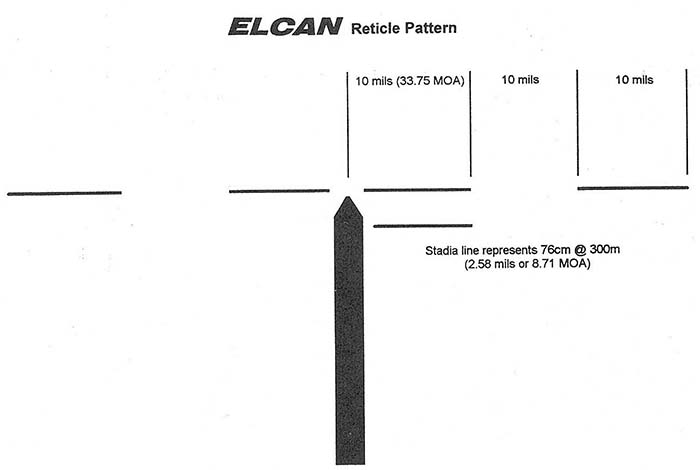
The EOTech Sight
It is suffice to say that the EOTech sight is the most high-tech of the lot. The development of the holographic sight can be traced back to the Rochester, New York based company LaserMax, Inc and their former CEO Will Houde-Walter. The EOTech sight has proven itself world over with many elite combat units and Police Department as well as Federal agencies. This is not a dot sight but a holographic sight. This by far has the largest screen giving the best overall peripheral vision to the shooter making it easy to fire with both eyes open. Due to no magnification this sight is ideal for any CQB environment.
This is a battery-operated sight (N or AA alkaline batteries) that has a hologram sight, which is an aiming dot with an outer circle around the point of aim dot. The intensity of the sight can be manipulated and adjusted by the user to suit the tactical lighting conditions. The sight has an automatic shut off. Models are also available for use with night vision scopes and glasses.
Due to this being a hologram, as long as the sight reticle can be seen in the screen regardless where, the rifle will shoot to point of adjustment aim of the sight. In other words, if the sight appears in the top right corner of the screen, that is where the bullet will go. The sight does not have to be centered in the screen. This means if the sight was covered partially in mud, snow or oil, as long as there was a small clean spot in which to view, the sight will still be usable.
Of all of the optics tested, this one was the easiest to see and use because of the combination of the shape of the reticle and the massive screen. The only draw back was the fact that the sight used batteries. Recently, ARMS, Inc. just released a throw lever (#54) mount for this sight. Accuracy was comparable to all others tested. Group shooting at 100 yards with Black Hills MK262 MOD 1 ammunition yielded groups just under 2 inches off a bench rest.
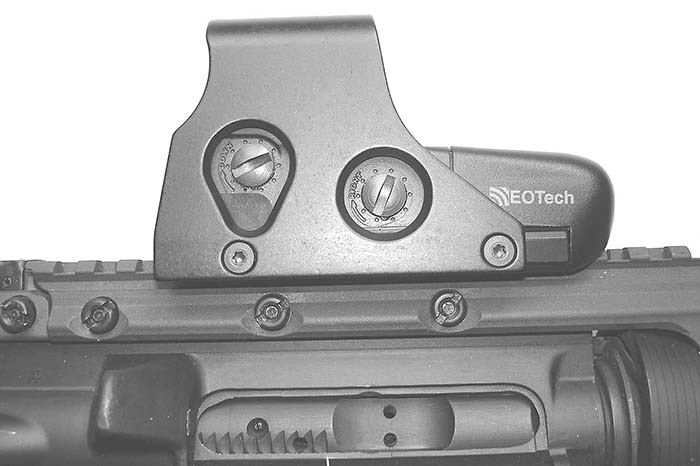
Leupold Mark 4 CQ/T
The Leupold Mark 4 CQ/T is a compromise between a scope and a reflex sight. The reticle may remain in a standard black recticle configuration or by clicking the dial it will light up from a dim to bright amber. What is unique about the CQ/T is the fact that the power can be turned down to 1x so that no magnification is made and the scope fills the role of a reflex sight. Then the power can be raised to the standard 2x and 3x magnification giving long-range capabilities. This is by far the largest and most cumbersome of all the scopes tested. However, it is very effective.
The sample sight took one AA battery – perhaps its largest draw back. This sight has Mil-Std-1913 rails at 3, 12 and 9 o’clock for mounting accessories. The reticle is an aiming point surrounded by a larger circle. Adjustments are made with a coin or a 5.56x45mm cartridge base. There are many different mounts available including the ARMS, Inc. (#12) throw lever mount.
This optic tested very well and is truly a well thought out design. Even if the battery was dead the standard black reticle is still there giving full use of the scope unlit. The low 2x to 3x power settings are ideal for a combat sight assuring quick target acquisition and follow up through recoil. The aiming reticle is small enough particularly with no illumination to do excellent long-range work. Only this sight and the Elcan sight are still useable without the illumination part of the sight.
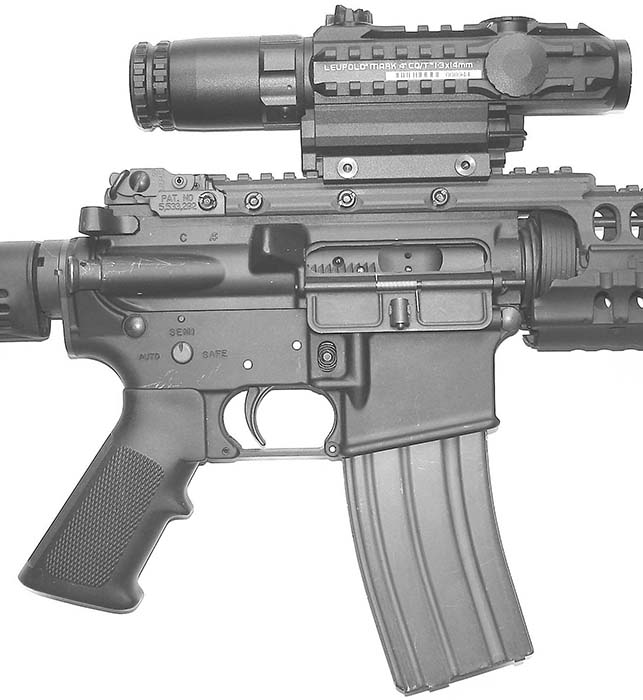
Conclusions
Law Enforcement has certainly benefited from the research and development of military CQB optics. Military units both foreign and domestic have used all of the mentioned optics. These optics greatly enhance the speed in which targets can get spotted, identified and ultimately engaged. All have strengths and all have weaknesses. But with proper training these optics will serve the soldier/police officer well.
Aimpoint, Inc.
3989 Highway 62 West, Suite 1
Bernville, AR 72616
(877) 246-7646
A.R.M.S., Inc.
Atlantic Research and Marketing Systems, Inc.
230 West Center Street
West Bridgewater, MA 02379
(508) 584-7816
Black Hills Ammunition
3050 Eglin Street
Rapid City, SD 57709
(605) 348-5150
Colt Defence, LLC.
P.O. Box 1868
Hartford, CT 06144
(800) 962-COLT
EOTech, Inc.
Electro-Optics Technologies
3600 Green Court, Suite 400
Ann Arbor, MI 48105-1570
(734)741-8868
Elcan/Armament Technology, Inc.
3045 Robie St. Suite 113
Halifax, Nova Scotia B3K 4P6
Canada
(902) 454-6384
Leupold & Stevens, Inc.
14400 Northwest Greenbrier Parkway
Beaverton, OR 97006
(503) 646-9171
Trijicon, Inc.
49385 Shafer Avenue
P.O. Box 930059
Wixom, MI 48393
(800) 338-0563
| This article first appeared in Small Arms Review V9N12 (September 2006) |










